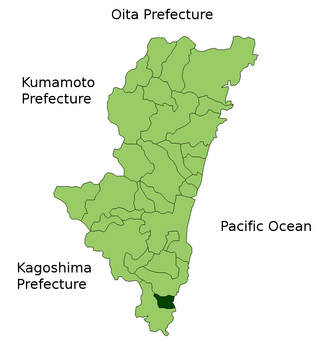Related Research Articles

Nichinan is a city in Miyazaki Prefecture, Japan. As of 1 May 2023, the city had an estimated population of 47,872 in 21482 households, and a population density of 89 persons per km². The total area of the city is 536.11 km2 (206.99 sq mi).

Kitagō was a town located in Minaminaka District, Miyazaki, Japan.

Nangō was a town located in Minaminaka District, Miyazaki, Japan.
Nangō was a village located in Higashiusuki District, Miyazaki Prefecture, Japan.
Saigo was a village located in Higashiusuki District, Miyazaki Prefecture, Japan.
Kitagō was a village located in Higashiusuki District, Miyazaki Prefecture, Japan.
(Japan > Yamaguchi Prefecture > Toyoura District)
Kamo was a district located in Hiroshima Prefecture, Japan.

Toyota is a district located in Hiroshima Prefecture, Japan. Currently the district has only the town of Ōsakikamijima.
(Japan > Hiroshima Prefecture > Numakuma District)

Japan > Mie Prefecture > Kitamuro District

Japan - Mie Prefecture - Minamimuro District
(Japan > Shizuoka Prefecture > Fuji District)
Tōda is a district located in Miyagi Prefecture, Japan.
Groups of Traditional Buildings is a Japanese category of historic preservation introduced by a 1975 amendment of the law which mandates the protection of groups of traditional buildings which, together with their environment, form a beautiful scene. They can be post towns, castle towns, mining towns, merchant quarters, ports, farming or fishing villages, etc. The Japanese government's Agency for Cultural Affairs recognizes and protects the country's cultural properties under the Law for the Protection of Cultural Properties.

Nichinan Station is a passenger railway station located in the city of Nichinan, Miyazaki Prefecture, Japan. It is operated by JR Kyushu and is on the Nichinan Line.

Obi (飫肥) is a district located in Nichinan, in the southern part of Miyazaki Prefecture, in the Kyushu region of Japan. During the Edo period, it was the Jōkamachi (castle town) of Obi Castle, which was the seat of the Obi Domain, which was ruled by the Ito clan. The district was originally planned and laid out in the early Edo period, and the historical townscape has been preserved to this day. The district has been designated as an Important Preservation District for Groups of Traditional Buildings in Japan, and is also known as the "Little Kyoto of Kyushu."

Obi Domain was a feudal domain under the Tokugawa shogunate of Edo period Japan, in what is now central Miyazaki Prefecture. It was centered around Obi Castle in what is now Nichinan, Miyazaki and was ruled by the tozama daimyō Itō clan for all of its history.
References
- ↑ "総務省|令和2年版 地方財政白書|資料編 〔附属資料〕 昭和60年度以降の市町村合併の実績" [Record of Municipal Mergers Since Showa 60]. 総務省 (in Japanese). Retrieved 2024-02-28.